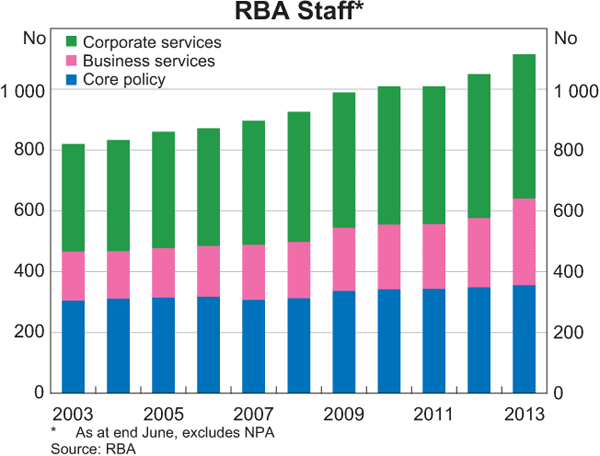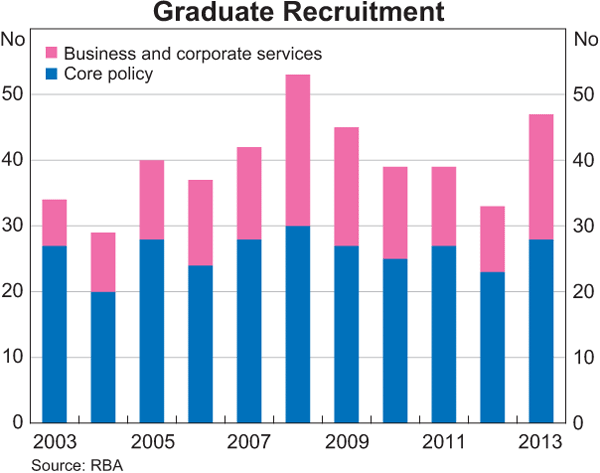Reserve Bank of Australia Annual Report – 2013 Management of the Reserve Bank
Operating Costs
A high proportion of the Reserve Bank's call on resources comes from activities associated with its key policy and operational responsibilities in financial markets, settlements and banking. As a central bank, its active presence in financial markets incurs significant costs for the systems that support these activities, which are, in large part, provided in pursuit of the public interest as they are systemically critical, particularly at times of financial stress when the Bank must provide liquidity and ensure the continuity of key components of financial infrastructure. Systems and assets that support these operational activities are constantly evolving and typically subject to gradual and incremental change. The Bank, however, currently anticipates change in its systems on a larger scale across a wider range of activities than has occurred in the past. This work is justified, in the Bank's view, by the public interest and will help the Bank to continue to meet its responsibilities in a changing financial environment. Some, though not all, of this new work can be expected to result in increased revenue, which will partly or fully offset the costs incurred.
A critical piece of financial infrastructure is the platform the Reserve Bank provides for real-time interbank settlements. This platform has evolved over the years, and continues to do so, in response to technological innovation and rising policy expectations. One major initiative is the new work that has begun, in response to the Payments System Board's Strategic Review of Innovation in the Payments System, to deliver the capability for fast payments for transactions of low value. Advances in technology have also fundamentally changed how services are delivered in the banking industry, leading the Bank to adopt new technology for its own systems, so that it will continue to provide contemporary and cost-effective services to its banking customers, the largest of which is the Australian Government. Parallel pressures are evident on systems to implement monetary policy, with, for example, innovation in dealing practices and instruments, partly in response to the financial crisis. New platforms are necessary to support operations in these instruments, for the Bank to better manage the associated credit risk and to accommodate Australia's response to change in the global regulatory regime for banks. As they advance, each of these systems must achieve higher levels of performance, stronger control – for the Bank and the financial system – and remain resilient to stress. The same-day settlement and banking projects are discussed in the chapter on ‘Banking and Payments’.
There was also further progress in the project to introduce a new series of banknotes to deal with the potential threat to the security of the note issue from the age of the current series (discussed in the chapter on ‘Currency’). Aside from tasks associated with designing and printing new banknotes, the program of distributing the new note issue, and withdrawing existing notes, presents a major storage and distribution challenge in its own right. The Reserve Bank will modernise its storage facilities and adopt modern logistics arrangements at the Note Printing Australia facility at Craigieburn, Victoria, so that control will be strengthened and storage and distribution of banknotes will become more efficient. The construction aspects of the banknote project will be subject to scrutiny by the Parliamentary Standing Committee on Public Works.
The range of projects, and interactions among them, gives rise to significant management challenges and a high level of risk that must be controlled as investment in new systems and assets progresses. The Reserve Bank is, accordingly, adding resources to risk management, compliance, and project management and governance, particularly around IT activities, to ensure that new project work is delivered efficiently, in a coordinated way and with minimum risk.
The range of initiatives outlined has begun to add significantly to the Reserve Bank's costs, both operating and capital, and will continue to do so for several years. Some projects have been underway for some time, including the upgrade of banking systems and development of the new banknotes, and these have already had an impact on costs. Other projects are planned to begin in the year ahead, including in markets and payments settlements.
In total, operating costs rose by about 8.2 per cent in 2012/13, to $267.3 million. Taking account of cost increases in business areas that were matched by revenue gains, costs from ongoing activities rose by about 6½ per cent, whereas operating costs from projects rose by 28.2 per cent. Project costs are expected to double in 2013/14, while business-as-usual costs are expected to grow at a similar pace as in 2012/13. As has historically been the case, staff costs represent the single largest operating expense for the Reserve Bank (this includes remuneration, on-costs and other staff-related costs, such as recruitment and training), accounting for over 60 per cent of operating costs.
| 2008/09 | 2009/10 | 2010/11 | 2011/12 | 2012/13 | |
|---|---|---|---|---|---|
| Staff costs | 132.6 | 141.6 | 148.1 | 156.7 | 169.0 |
| Other costs | 82.8 | 83.3 | 86.0 | 90.4 | 98.3 |
| Underlying operating costs | 215.4 | 224.9 | 234.1 | 247.1 | 267.3 |
| Cost of redundancies | 2.0 | 0.5 | 1.3 | 1.9 | 2.5 |
|
(a) Costs associated with the ongoing operation of the Reserve Bank, excluding NPA Source: RBA |
|||||
Our People
Over the year to June 2013, the total number of employees at the Reserve Bank increased by 64 to 1,115, a rise of around 6 per cent. The increase in staff numbers was concentrated in the business and support areas of the Bank and around half reflected additional resources for major projects.
The Reserve Bank recruited 150 people over the past financial year. Forty-seven recent graduates, representing around one-third of all new employees, began the Graduate Development Program this year. Forty per cent of graduate recruits are working in the Bank's business and corporate services areas. While the majority of graduates hold economics or finance degrees, the business and corporate services areas also recruited graduates with degrees in science, engineering, accounting and information technology. During the year, the Bank was awarded the inaugural ‘Best Employer’ award by the Australian Association of Graduate Employers for the employer providing its graduates with the best overall experience during their first 12 months on the job.


Meeting the Reserve Bank's responsibilities requires high-calibre employees. Around half of the Bank's employees have degree qualifications and around a fifth have postgraduate qualifications. A number of programs support the Bank's aim of recruiting professional employees of suitable quality. Honours graduates are sought through the Cadetship Program, which provides students of high potential in relevant disciplines with work experience at the start of their honours year. Financial support during that year is available if cadets are offered, and accept, a place on the next Graduate Development Program.

Financial support is also provided to current staff for part-time study in disciplines related to their work, with around 80 employees studying part-time. In addition, the Reserve Bank provides support for full-time postgraduate study at universities in Australia and overseas, and in the past year four employees were awarded such assistance. Employees who are supported for full-time study are required to reimburse these costs if they resign either while studying or before completing an agreed period of work after returning from study.
Other training is provided on the job, through formal courses and, for a limited number of staff, through attachments to other organisations. Over the past year, for example, the Reserve Bank has had staff on secondment with the Departments of the Treasury and the Prime Minister and Cabinet, the International Monetary Fund, the Bank for International Settlements, the Organisation for Economic Co-operation and Development, the Bank of England, the Bank of Canada and the Federal Reserve Bank of New York. At the same time, the Bank has hosted secondees from the Departments of the Treasury and the Prime Minister and Cabinet, the Australian Prudential Regulation Authority and the Bank of Canada.
Training was also provided to staff on work health and safety (WHS) obligations and contemporary WHS matters such as mental health at work. Those staff who have a greater level of WHS responsibility, or require a greater level of training because of the nature of their role, also attended specialist training or conferences during the year. The Reserve Bank regards the safety and wellbeing of employees to be of paramount importance. The Bank's WHS activities are covered in the chapter on ‘Statutory Reporting Obligations’.
A Staff Discussion Series was launched during the year to raise employees' awareness about the roles, activities and range of work undertaken across the Reserve Bank. The series offers an opportunity for staff to participate in discussions about new Bank projects, policies and other activities. It is envisaged that there will be six to eight presentations in the series each year. Topics covered during the past year included the Next Generation Banknote project, the renovation of banking systems project, managing the cash rate and the Bank's payments system responsibilities.
The Reserve Bank strives to offer a total remuneration package that attracts and engages high-calibre employees. Independent consultants are engaged to ensure that remuneration policies are consistent with market practice. The Bank's Workplace Agreement provided for a 4 per cent salary increase in 2012/13 for the staff it covers, with scope for a modest additional payment in recognition of good performance. Staff on individual contracts received, on average, a salary increase comparable to that provided by the Workplace Agreement.
Facilities
The Reserve Bank owns premises in locations where there is a business need to do so, including its Head Office in Sydney; a conference/training centre in Kirribilli, Sydney; office buildings in Melbourne and Canberra; the note printing facility at Craigieburn, north of Melbourne; and the Business Resumption Site in outer Sydney. In addition to the buildings it owns, the Bank leases accommodation for its State Offices in Adelaide, Brisbane and Perth – where its requirements for space are quite small – and for its offices in London, New York and Beijing.
The value of the Reserve Bank's property assets increased by $12.6 million to $329.0 million in 2012/13, primarily because of an increase in the value of the facility at Craigieburn. Surplus accommodation in the Bank's properties is leased to external tenants. Gross income from these leases amounted to $9.0 million in 2012/13.
During the year, the Reserve Bank continued to strengthen the resilience of facilities supporting critical operations. In Sydney, infrastructure associated with the auxiliary power system was upgraded to provide greater reliability in the event of interruptions to the mains supply; this included new cooling, fuel delivery and control systems. The program to upgrade Head Office's hydraulic systems also continued during the year with the installation of a flood control drainage system. At Craigieburn, work commenced to replace and upgrade the remaining mechanical infrastructure supporting the facility's air-conditioning and heating systems.
A number of other capital improvements were undertaken over 2012/13 to address life-cycle replacements or the refurbishment of accommodation in response to changing business needs. At Head Office, a basement improvement project commenced to rationalise storage areas, extend lift services and update amenities, and some office accommodation was refurbished. At Craigieburn, office and laboratory areas were consolidated and upgraded. Planning is well underway for the Currency Storage Project, which involves the development of a new storage and processing facility as part of the Next Generation Banknote project.
Environmental Management
The Reserve Bank is committed to improving the environmental performance of its operations. The Environmental Management Committee (EMC) in the facilities management function of the Bank has developed policies that are in accordance with the principles of ecologically sustainable development as set out in the Environment Protection and Biodiversity Conservation Act 1999. These policies reduce the impact of the Bank's operations on the environment and include the following initiatives:
- reducing energy, water and paper consumption
- procuring 10 per cent of electricity needs from renewable (green) sources
- increasing the recycling of paper, co-mingled waste and printing cartridges
- adopting environmentally sustainable designs for office fit-outs
- using 50/50 recycled paper
- greater use of fuel-efficient vehicles.

2. David Stanton (left) and Jamie Moorby, Facilities Management Department, on the roof of the Canberra building with the new air-conditioning chiller
Electricity consumption decreased by 1 per cent during 2012/13 compared with the average of the past five years. Further improvements in electricity consumption were realised during the year at most of the Reserve Bank's sites, with the biggest reduction in the Canberra building, where the air-conditioning and heating system was recently upgraded. Head Office maintained the lower levels of consumption attained the previous year.
Gas consumption during 2012/13 was similar to the previous year and 4 per cent lower than the average for the previous five years. Water consumption increased by 3.5 per cent in 2012/13, as a result of higher ambient temperatures, but was 5 per cent lower than the average of the previous five years.
The amount of waste produced by the Reserve Bank during 2012/13 rose by 3 per cent compared with the five-year average. The waste recycled across all facilities increased by 29 per cent. Landfill waste from the Bank's New South Wales sites is now sent to bioreactors that capture methane to produce ‘green’ electricity.
The Reserve Bank's EMC will continue to set targets and pursue lower energy and water consumption. Some of the initiatives being investigated include extending sub-metering systems and improvements in information technology operations at the Bank's sites.
Consultancies
The Reserve Bank employs outside contractors and professional service providers to carry out specific tasks where necessary and also, from time to time, uses consultants. Consultants are engaged where the Bank lacks specialist expertise or when independent research, review or assessment is required. Consultants are typically engaged to investigate or diagnose a defined issue or problem; carry out defined reviews or evaluations; or provide independent advice or information to assist in the Bank's decision-making. Prior to engaging consultants, the Bank takes into account the skills and resources required for the task, the skills available internally and the cost-effectiveness of engaging external expertise. Spending on consultancies over the past six years is shown in the table.
| 2007/08 | 260,000 |
|---|---|
| 2008/09 | 63,000 |
| 2009/10 | 61,000 |
| 2010/11 | 102,000 |
| 2011/12 | 535,000 |
| 2012/13 | 1,190,000 |
|
(a) Sum of individual consultancies that cost $10,000 or more (excluding GST) Source: RBA |
|
As in previous years, consultancies during 2012/13 covered a range of activities, including corporate governance, security arrangements and risk management. Spending on consultants was also significantly boosted by ongoing work on several major projects, most notably the development of the new series of banknotes. These projects are expected to boost expenditure on consultancies for a number of years.